小学英语教案全英模板
小学英语教案万能模板5篇
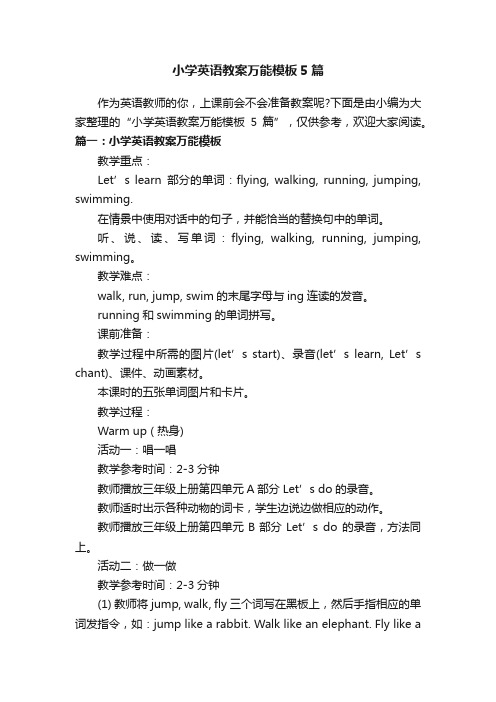
小学英语教案万能模板5篇作为英语教师的你,上课前会不会准备教案呢?下面是由小编为大家整理的“小学英语教案万能模板5篇”,仅供参考,欢迎大家阅读。
篇一:小学英语教案万能模板教学重点:Let’s learn部分的单词:flying, walking, running, jumping, swimming.在情景中使用对话中的句子,并能恰当的替换句中的单词。
听、说、读、写单词:flying, walking, running, jumping, swimming。
教学难点:walk, run, jump, swim的末尾字母与ing连读的发音。
running和swimming的单词拼写。
课前准备:教学过程中所需的图片(let’s start)、录音(let’s learn, Let’s chant)、课件、动画素材。
本课时的五张单词图片和卡片。
教学过程:Warm up ( 热身)活动一:唱一唱教学参考时间:2-3分钟教师播放三年级上册第四单元A部分Let’s do的录音。
教师适时出示各种动物的词卡,学生边说边做相应的动作。
教师播放三年级上册第四单元B部分Let’s do 的录音,方法同上。
活动二:做一做教学参考时间:2-3分钟(1) 教师将jump, walk, fly三个词写在黑板上,然后手指相应的单词发指令,如:jump like a rabbit. Walk like an elephant. Fly like abird.学生边跟读边做相应的动作。
(2) 教师继续发指令,学生做动作,适时提问:What are you doing?,引导学生回答:I’m (jumping) (like a rabbit).。
教师在黑板上的jump后面加上ing,呈现新词:jumping。
同法引入walking 和flying。
2、Presentation (新课呈现)活动三:学一学教学参考时间:10-12分钟教师出示Let’s learn部分的教学课件,提问:What animals can you see in the picture?让学生回答。
小学英语的全英文教案范文

小学英语全英文教案范文一、Lesson IntroductionObjective: To introduce oneself and ask questions about others. Materials: Flashcards of animalsProcedure:1. Greet the students and ask them to sit in a circle.2. Show the flashcards of animals one one and ask the students to repeat the name of the animal in English.3. Introduce yourself saying, "Hello, my name is [Your Name]. I am a teacher. What's your name?" Ask the students to introduce themselves.4. Practice asking and answering questions like, "How old are you?" and "Where are you from?"二、Lesson 2: Greetings and IntroductionsObjective: To learn how to greet and introduce oneself.Materials: Flashcards of greetings and introductionsProcedure:1. Start the class with a warm-up activity, such as singing a greeting song.2. Show the flashcards of greetings and introductions, such as "Hello," "Good morning," "Good afternoon," and "Goode." Ask the students to repeat after you.3. Practice asking and answering questions like, "How are you?" and "I'm fine, thank you."4. Introduce a new student to the class and ask the students to greet and introduce themselves.三、Lesson 3: ColorsObjective: To learn how to name and describe colors in English. Materials: Flashcards of colorsProcedure:1. Start the class showing a colorful picture or object and ask the students to name the colors.2. Show the flashcards of colors one one and ask the students to repeat the color name in English.3. Practice describing colors using phrases like, "It's blue," "It's a red car," and "The sky is blue."4. Draw a colorful picture with the students and ask them to name the colors as you draw.四、Lesson 4: Numbers 1-10Objective: To learn how to count from 1 to 10 in English.Materials: Number flashcards, objects to countProcedure:1. Start the class counting with the students, "One, two, three, four, five." Continue counting up to 10.2. Show the number flashcards one one and ask the students to repeat the number in English.3. Give the students a set of objects, such as counters or toys, and ask them to count the objects using English numbers.4. Play a number game, such as "Simon Says" or "Number Memory," to reinforce the counting skills.五、Lesson 5: AlphabetObjective: To learn the English alphabet and the sounds of each letter. Materials: Alphabet flashcards, letter sounds chartProcedure:1. Start the class singing the "Alphabet Song" to familiarize the students with the English alphabet.2. Show the alphabet flashcards one one and ask the students to repeat the letter name in English.3. Expln the sounds of each letter in the alphabet using a letter sounds chart.4. Practice tracing the letters of the alphabet on a large whiteboard or chart paper, and ask the students to follow along.六、Lesson 6: Family MembersObjective: To learn how to name family members in English. Materials: Flashcards of family membersProcedure:1. Start the class asking the students about their family members in their native language.2. Introduce the concept of family members in English showing the flashcards of family members, such as "mother," "father," "brother," "sister," and "grandparent."3. Practice asking and answering questions about family members, like "Who is your mother?" and "I have a sister."4. Ask the students to bring a picture of their family and describe their family members in English.七、Lesson 7: Dly RoutinesObjective: To learn how to describe dly routines in English. Materials: Flashcards of dly routinesProcedure:1. Start the class discussing the dly routines of the students in their native language.2. Introduce the concept of dly routines in English showing the flashcards of dly routines, such as "wake up," "eat breakfast," "go to school," and "play."3. Practice asking and answering questions about dly routines, like "What do you do in the morning?" and "What do you do after school?"4. Ask the students to role-play their dly routines using English words and phrases.八、Lesson 8: ClothingObjective: To learn how to name and describe different types of clothingin English.Materials: Flashcards of clothingProcedure:1. Start the class discussing the types of clothing worn in different seasons.2. Introduce the concept of clothing in English showing the flashcards of different types of clothing, such as "shirt," "pants," "dress," "sunglasses," and "hat."3. Practice asking and answering questions about clothing, like "What are you wearing today?" and "I am wearing a skirt."4. Ask the students to bring a picture of themselves in different types of clothing and describe their clothing in English.九、Lesson 9: Food and DrinksObjective: To learn how to name and describe different foods and drinks in English.Materials: Flashcards of food and drinksProcedure:1. Start the class discussing the types of food and drinks liked the students.2. Introduce the concept of food and drinks in English showing the flashcards of different food and drink items, such as "apple," "banana," "orange," "milk," and "water."3. Practice asking and answering questions about food and drinks, like "What is your favorite fruit?" and "Can I have some water, please?"4. Ask the students to bring a picture of their favorite food or drink and describe it in English.十、Lesson 10: Review and AssessmentObjective: To review the topics covered in the previous lessons and assess the students' understanding.Materials: Review worksheets, flashcardsProcedure:1. Start the class reviewing the topics covered in the previous lessons, such as greetings, introductions, colors, numbers, family members, dly routines, clothing, food and drinks.2. Conduct a mini-assessment to evaluate the students' understanding asking them to answer questions related to the topics.3. Use flashcards to test the students' vocabulary retention asking them to name the items in English.4. Provide review worksheets for the students to plete, which include exercises like fill in the blanks, match the words with their pictures, and write short sentences using the learned vocabulary.5. Give feedback to the students on their performance and encourage them to continue practicing their English skills.重点和难点解析一、Lesson Introduction重点关注环节:Students' ability to ask and answer questions about themselves.难点解析:This lesson introduces the concept of asking and answering questions about oneself, which is a fundamental skill in language learning. The students may find it challenging to express their personal information accurately and confidently in English.二、Lesson 2: Greetings and Introductions重点关注环节:Students' ability to use greetings and introduce themselves.难点解析:Using proper greetings and introductions is crucial in dly munication. The students might struggle with remembering and applying the correct phrases in different situations.三、Lesson 3: Colors重点关注环节:Students' ability to name and describe colors in English. 难点解析:Naming and describing colors can be challenging for students, especially those whose native language does not use the same color palette as English.四、Lesson 4: Numbers 1-10重点关注环节:Students' ability to count from 1 to 10 in English.难点解析:Counting is a foundational math skill that can be difficult for students to master when learning a new language, as it involvesunderstanding the numerical system and sequencing.五、Lesson 5: Alphabet重点关注环节:Students' ability to recognize and pronounce each letter of the English alphabet.难点解析:The English alphabet may have letters that are not present in the students' native language, making it challenging for them to recognize and pronounce them correctly.六、Lesson 6: Family Members重点关注环节:Students' ability to name family members in English and ask about others'.难点解析:Understanding and using family vocabulary can be emotional and personal for students. They may find it difficult to remember the English words for extended family members or to ask about others' families.七、Lesson 7: Dly Routines重点关注环节:Students' ability to describe their dly routines in English. 难点解析:Describing routines involves sequencing and using past tense verbs, which can be plex for beginners to grasp.八、Lesson 8: Clothing重点关注环节:Students' ability to name and describe different types of clothing in English.难点解析:Clothing terms can be abstract and may not have directtranslations in students' native languages. Additionally, students may be self-conscious about discussing their attire.九、Lesson 9: Food and Drinks重点关注环节:Students' ability to name and describe different foods and drinks in English.难点解析:Food and drink vocabulary can be extensive, and students may have difficulty remembering the names of specific items or describing preferences.十、Lesson 10: Review and Assessment重点关注环节:Students' ability to review and apply the knowledge gned from the previous lessons.难点解析:Assessment can be stressful for students, especially if they feel unprepared. Ensuring that the review is prehensive and allows for individualized learning is crucial.这些教案环节涵盖了从自我介绍到日常生活中的各种主题,每个环节都有其特定的重点和难点。
最新小学英语全英说课稿(精选10篇)
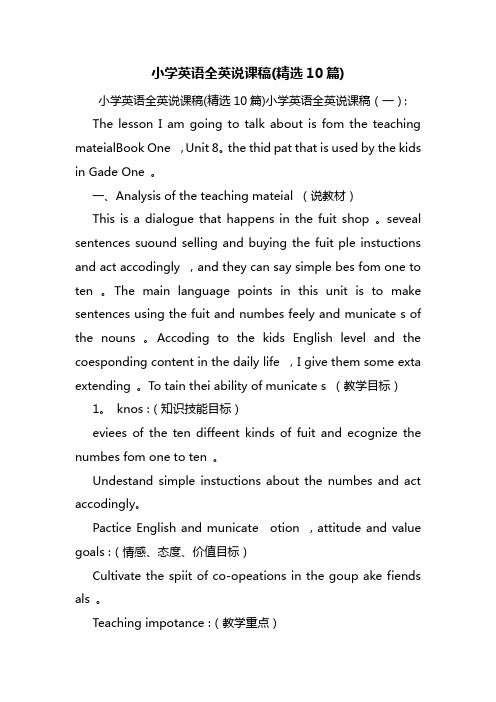
小学英语全英说课稿(精选10篇)小学英语全英说课稿(精选10篇)小学英语全英说课稿(一):The lesson I am going to talk about is fom the teaching mateialBook One ,Unit 8。
the thid pat that is used by the kids in Gade One 。
一、Analysis of the teaching mateial (说教材)This is a dialogue that happens in the fuit shop 。
seveal sentences suound selling and buying the fuit ple instuctions and act accodingly ,and they can say simple bes fom one to ten 。
The main language points in this unit is to make sentences using the fuit and numbes feely and municate s of the nouns 。
Accoding to the kids English level and the coesponding content in the daily life ,I give them some exta extending 。
To tain thei ability of municate s (教学目标)1。
knos :(知识技能目标)eviees of the ten diffeent kinds of fuit and ecognize the numbes fom one to ten 。
Undestand simple instuctions about the numbes and act accodingly。
小学英语教案全英文版
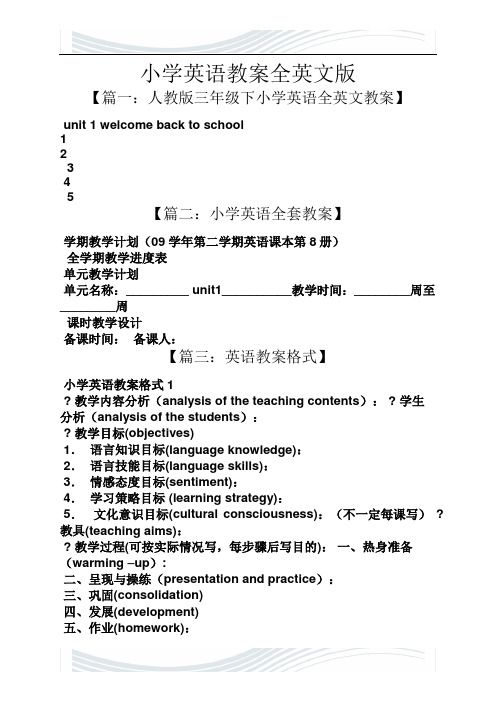
小学英语教案全英文版【篇一:人教版三年级下小学英语全英文教案】unit 1 welcome back to school12345【篇二:小学英语全套教案】学期教学计划(09学年第二学期英语课本第8册)全学期教学进度表单元教学计划单元名称:_________ unit1__________教学时间:________周至________周课时教学设计备课时间:备课人:【篇三:英语教案格式】小学英语教案格式1? 教学内容分析(analysis of the teaching contents): ? 学生分析(analysis of the students):? 教学目标(objectives)1.语言知识目标(language knowledge):2.语言技能目标(language skills):3.情感态度目标(sentiment):4.学习策略目标 (learning strategy):5.文化意识目标(cultural consciousness):(不一定每课写)? 教具(teaching aims):? 教学过程(可按实际情况写,每步骤后写目的):一、热身准备(warming –up):二、呈现与操练(presentation and practice):三、巩固(consolidation)四、发展(development)五、作业(homework):? 板书设计:? 附上练习:范例一:unit3 let’s talk 第一课时小学三年级教学重点:how are you? fine, thank you. 等问候语的学习。
教学难点: 1、how are you? 的得体运用。
2、fine, thank you.中 fine 一词字母 i 的发音不容易到位。
教具准备:1、本课let’s talk/a 部分的教学课件。
2、教师为学生准备3—4个扩音器。
3、本课时教学配套的录音带,以及歌曲“hello”“head, shoulders, knees and toes”的录音带。
小学英语全英说课稿模板
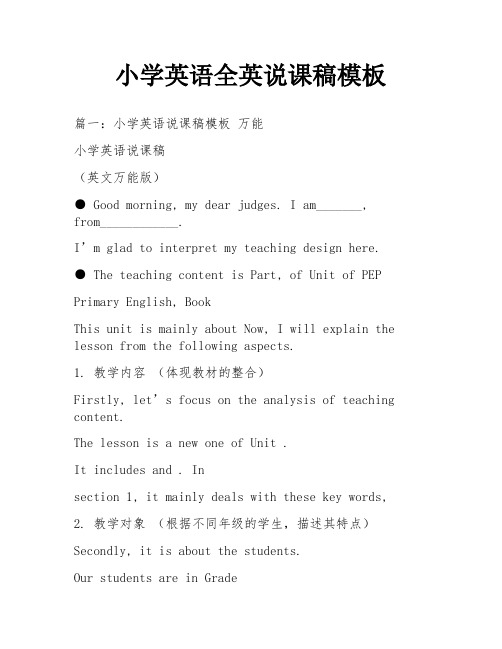
小学英语全英说课稿模板篇一:小学英语说课稿模板万能小学英语说课稿(英文万能版)● Good morning, my dear judges. I am_______, from____________.I’m glad to interpret my teaching design here.● The teaching content is Part, of Unit of PEP Primary English, BookThis unit is mainly about Now, I will explain the lesson from the following aspects.1. 教学内容(体现教材的整合)Firstly, let’s focus on the analysis of teaching content.The lesson is a new one of Unit .It includes and . Insection 1, it mainly deals with these key words, 2. 教学对象(根据不同年级的学生,描述其特点)Secondly, it is about the students.Our students are in GradeThey are active and curious, interested in new things.After learning English for years, they have some basic Englishbackground knowledge, so the teacher should attach importance to themunication with them, providing them the chances of using language.They have learnt English for years, and have already knownIt is not difficult for them to understand and use the language 3. 教学目标(根据具体内容定目标和要求)So, I set the following aims.By the end of the lesson, students will be able to read, recognize, and usethese words:And, these sentences:By the end of the lesson,Ss can understand the and get useful information from the throughattentive listening / reading.Ss are able to talk about Ss can use to give suggestions onSs’ abilities of listening and speaking will be developed.(Affect;Learning strategies;cultural awareness.)In this lesson, the emotional aim isto help students cultivate and foster their abilities of working ingroups.to foster Ss’ consciousness of good-cooperation and properpetition.to help Ss cultivate their abilities to analyze and solve problemsindependently.to foster Ss’ initiative and creativeness.to help Ss to recognize and identify the differences between Chinese and English cultures on to help Ss know some and prehend theto make sure that Ss can use Correctlyskillfully.to develop Ss’ interest in English.The difficult point is:The pronunciation of 教法学法Fourthly, it talks about teaching methods.andIn this lesson, I will mainly use “Task-based teaching method”,“Communicative language teaching method” and “TPR teaching method”,and so on.4. 教学过程① 具体steps 根据具体内容定;② 板书steps + purpose 说明;③ 如有可能,同时完成layout设计;Next, let’s focus on the teaching procedures.I will finish the lesson in steps.It will cost about mins.After greeting with the Ss, I will begin the lesson by singing the song together with the Ss.Purpose:The purpose of this is to form a better English learning surrounding forthe Ss, and, at the same time, it provides situations to review the learntknowledgefor the next step.It will cost about mins.With the help of the PPT, I set a situation of by to stimulate the Ss’ interest of the lesson.By playing the PPT, IAnd then, (板书layout)The purpose of this is to present the new words and sentences in thesituation, which relates to the Ss’ real life experiences, to help the Ssunderstand the language easily and naturally.After presenting each new word (by the guessing game), I will impart theknowledge of pronunciation rules in teaching the new words.It is called Phonics.It can facilitate the Ss’ abilities to pronounce the words, and help them toremember the spelling of the words.(机械上口;有意义操练;let’s do;课文对话表演;)It will cost mins, including篇二:小学英语说课稿(全英版)小学英语说课稿①Good afternoon , Ladies and Gentlemen !My name is Wu Dan . I e from Tanggangzi School .I am very glad to be standing here and talking about Lesson 10 ,which is from Fun with English Book 3 Unit 2 .My teaching report includes four parts . Part 1 To analyze the book1.There are 3 units in Book 3 . This is Lesson 10 . The central item is how to master another sentence to express “ What’s the time ? ” and how to buy something. Using “ What’s the time ? ” hungry , cakes, bread and so on . We’ll study and drill the sentences and the word ’s pronunciation .2. According to the teaching outline and bining the students ’ situation , I make the teaching aims of this lesson as follows .a .The first is the aim of knowledge .It’s to learn and master two sentences. What time is it? I am hungry and then using them to express thetime and go shopping fluently and freelyb. The second is the aim of abilitiesThe creative spirit is quite important to the students. So I will pay much attention to train it in my class. Otherwise. I will try to train the students listening, speaking, reading and writing abilities, Mainlyimprove their municative abilities and encourage them to speak more English.C. The third is the aim of emotionMake the students have successful feeling and achievement. And make them be in English study.3.Important pointsThe first is to master and use the two sentences. What time is it? I’m hungry. The second is to master the usage of the words hungry, cakes and bread.4.Difficult points.I t’s the pronunciation of the two words. hungry, cakes, and how to use them fluently and freely . Part 2 . Teaching and learning methodsMake the students take part in class . Ask and answer in pairs and groups . I’ll use municative method , discussing method and seeing and hearing method to teach this lesson .Part 3 . Teaching aids .In order to interest the students . I’ll use a clock , recorder , cards and some food as my teaching aids . Part 4 . Teaching procedure .Step 1 RevisionBefore my class , I’l l get the students to sing an English song to keep themselves relax . Then I’ll use a clock to act it . What’s the time ? What’s thetime ? It’s eight o’clock . I’ll show threenumbers . When the students answer It’s ten o’clock . I’ll say : It’s ten . Today we’ll learn Lesson Ten . Then I'll put the clock on the blackboard .Step 2 Presentation and drillFirst I’ll point to the clock and ask , what time isit ? Students answer It’s ten . Then I go on moving thehands and ask .What time is it ?Students answerquickly .Second I’ll drill the sentences What time is it ?It’s ----- .pairs in pairs or row by row .Third When the students answer It’s 12:00 o’clock . I’ll point to my stomach and say .Oh I’m hungry .and I’ll eat a cake . Then I’ll go on saying I’mhungry .and I’ll eat another cake . I’ll act it four or five times . Then I ask a student to act it . I’m hungry , too . I’ll say two cakes , please .and the sentences .I’m hungry . Two cakes ,please.Forth :Listen to the dialogue and answer my questions.1.What time is it?2.How many cakes?Step 3 ConsolidationI’ll train the creative spirit of the students.I’ll give them three please. To act the dialogue freely .First at the 219 Park,second fruit shop Third department store.Step4.HomeworkEncourage my student to the market to buy something with his friends or parents.②Good morning, everyone!Today, I’ll say something about Unit 9 Part A in Book 4 of Oxford English.Background on the reformation of curriculum, this book can connect the life and act, emphasize the interest and experience of the Ss, the pictures are active and vivid. Grade four is the initial stage of English learning, so it stresses on the emotion of the Ss, creates a well beginning for the Ss. This Unit has 7 parts, we’ll learn Part A mainly, it embodies the repeating characterize. Review the learned language points “Where’s…”and the new language points will be represented in the following units. So this unit forms connecting links with a special meaning in this book.The content of this period is to use“Where’s\are…” to determine the place. And according to the contents and the fact of the Ss, I establish the following three teaching aims of this period:The first one: students can listen, read, say andspell the following words: a glass, a fridge, an egg, bread and a table.The second one: students can listen, read, say andwrite the following daily expressions: What’s for breakfast?Have some juice then.The third one: students can listen, read, say andwrite the following sentence p atterns: Where’s\Where are the\my…It’s \They’re…There’s no …in \on \near…I think the most difficult point of this period is to make sure the students can use the patterns“Where’s\Where are…and There is no …in\on\near…” in their daily life correctly.And I will use some pictures, words and sentence cards, a tape recorder and the multi-media puter to help me achieve the aims.The task-based method, municated method, group cooperate method will be used in this period. To acplish the aims, I design the following steps:Step 1 Songs and the game arousers the emotion.In order to attract the Ss’ attention and constructan atmosphere of learning English, I let the studentssing some English songs and play the game “Simon says”. At the same time the game can review the prep, serve the knowledge as foil and consist the appearance of the knowledge.Step 2 Change class to life, happy to say.The substance of language is munication and the environment of munication is life. So when I present the sentence pattern “What’s for breakfast?” Ifirst show a clock to elicit the time for breakfast, teach the sentence. Then show my own photo of having breakfast, Ss ask and guess. In this way I can attract Ss’ attention, encourage Ss to ask Qs with the new knowledge.Most of the Ss have learnt the sentence pattern: Where’s…? so I design a task for Ss to help Helen find the food and drinks for breakfast, and teach the new language points: Where are…? They’re … Meanwhile stick the sentences on the Bb.After some practice by asking and answering, I present the next language points:There’s no …in\on\near…Have …then.And I will stick these sentence patterns on the Bb. Finally I’ll let the Ss do pair works to consolidate them. Step 3 Listen to the tape and Ss imitate to read and say.As the new reformation of curriculum, emphasized the traditional class attach importance to the mechanical teaching, neglect the experience and participation,for example, the five-step method. So in this lesson, after presentation, I ask Ss to listen to the tape with three Qs, read in different roles and in pairs, then try to recite the text.Step 4 Ss be the main body, T makes a guider.In class, Ss play as a host, and the T makes an influence on guiding, help Ss to act the learnt dialogue, it can stress the position of the Ss, and arouse their interest.Then I show a carton with no voice, ask Ss to make a dialogue in pairs.There are lots of ways to consolidate the new knowledge. Playing game is a good way. So according to the physiology of Ss, I hold a group petition during the game, ask Ss to finish the blanks. In this way can develop Ss’ good habits and achieve the aim of mastering the learned knowledge in situation. Step 5 Change class to life, learn by themselves.Is this the end of the class? I do n’t think so. If there is an end, I think it should be in the life. So I extend this class, encourage Ss to use the learned to municate with each other in their life.In a word, the whole period is based on tasks, which are designed from easy steps to steps that arechallenging. When the Ss are carting out the tasks, they can acquire information, knowledge, and havetheir ability and skills trained.That’s all. Thanks a lot for your attention.全英说课稿Good morning everyone. Standing here, I’m very happy and excited. It’s my greathonor to be here to present my lesson, and the chance is very precious for me. And I’ll try my best. Today I’ll talk about unit frommy contents consist of 8 parts Analysis of the teaching materialAnalysis of the studentsTeaching methodsTeaching aims and demandsTeaching aidsTeaching procedureBlackboard designAnd conclusionWell, firstly, I’ll talk about part 1 analysis of the teaching material. I have concluded the features of…….1 . there are a lot pictures. For this, the kids will be interested in the book. As we all know thatinterest is best teacher for the students.2. It lays stress on the munication. According to the problem of Chinese students learning English , the book design a lot of material to improve the students’ a bility of listening speaking, reading, and writing. So I think the book is very good.Then I’ll talk about next part analysis of the students. It is known to us that the kids are very active and like playing games very much, so during my class, I’ll design some interesting games to activate them to participate and learn something. They will also be interested in the class.Next I’ll talk about teaching methods. My teaching methods are task-based approach and situational approach. Using different methods can make the class active.Let’s move on to another part, teaching aims and demands. There are knowledge aims and ability aims.Knowledge aims are to enable the students to master the words and phrases:………. And the sentences:…Ability aims are To improve stud ents’listening and speaking ability by reading and practicing the dialogue.Next is the teaching aids. In this class, I’ll use pictures, PPT and tape recorder. These can arouse the students’ interest in English.Now I’ll talk about most important part tea ching procedure. It consists of 5 steps. Warning up, lead-in, contents key points and difficult points and homework. Step1 is warming up. Here I’ll use PPT to play a English song Bingo for the students and I’ll ask them try to follow it to sing together. By this, the students can beinterested in it and pay their attention to our class easily and improve their ability of speaking.Step2 is lead-in (导入根据所授内容设计,可通过展示与本课有关的话题或者图片等等引出本课话题)Step 3 is contents(本部分为主要授课内容及组织的课堂活动。
全英版小学英语教案【三篇】

【导语】⾼尚的理想是⼈⽣的指路明灯。
有了它,⽣活就有了⽅向;有了它,内⼼就感到充实。
迈开坚定的步伐,⾛向既定的⽬标吧!以下是为⼤家整理的《全英版⼩学英语教案【三篇】》供您查阅。
⼩学英语教案全英版⼀: Part A Let’s say, Let’s chant Part C Culture Teaching Aims : 1. Be able to listen, say, recognize the words: apple, ant, boy, bag, Coke, coffee. 2. Be able to listen, say, read and write these three letters: A a; B b; C c 3. Through the chant review the letters of ABC, train a sense of group identity. Focus Points & Difficult Points : Read the letters: Big letter C, small letter c; Write down them correctly and handsomely. Teaching Preparation: 1. Letter cards ,some word pictures, word cards: apple boy eraser ant crayon body head cake Coke coffee bag ball 2. A little blackboard with four-line format and a ball. Designing for the blackboard: panda beaver eagle kangaroo (pictures) China Canada America Australia (words) Teaching Steps: Step1. Warm –up 1. Sing a song. 2. Free talk T: Hello. I’m Wendy. I’m from Hangzhou. S1: Hello! I’m ... I’m from Hangzhou,too. T: Nice to meet you. S: Nice to meet you, too. T: Let’s play. Ok? S: Great! T: Watch out! (T throws the ball.) S: Oh, no. Make a similar dialogue with your partner. Step2.Presentation. 1. 1)T : Today, we will learn letters. Do you know letters? Just as A,B,C…… They are letters. What’s the meaning of letters? S: 字母。
小学pep英语教案5篇
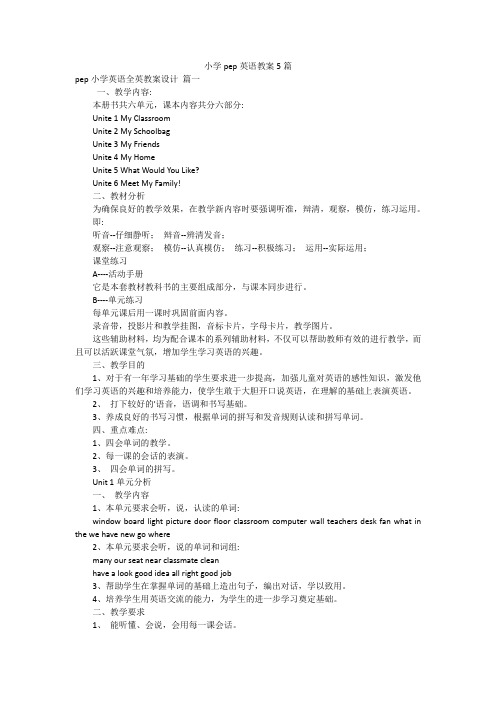
小学pep英语教案5篇pep小学英语全英教案设计篇一一、教学内容:本册书共六单元,课本内容共分六部分:Unite 1 My ClassroomUnite 2 My SchoolbagUnite 3 My FriendsUnite 4 My HomeUnite 5 What Would You Like?Unite 6 Meet My Family!二、教材分析为确保良好的教学效果,在教学新内容时要强调听准,辩清,观察,模仿,练习运用。
即:听音--仔细静听;辩音--辨清发音;观察--注意观察;模仿--认真模仿;练习--积极练习;运用--实际运用;课堂练习A----活动手册它是本套教材教科书的主要组成部分,与课本同步进行。
B----单元练习每单元课后用一课时巩固前面内容。
录音带,投影片和教学挂图,音标卡片,字母卡片,教学图片。
这些辅助材料,均为配合课本的系列辅助材料,不仅可以帮助教师有效的进行教学,而且可以活跃课堂气氛,增加学生学习英语的兴趣。
三、教学目的1、对于有一年学习基础的学生要求进一步提高,加强儿童对英语的感性知识,激发他们学习英语的兴趣和培养能力,使学生敢于大胆开口说英语,在理解的基础上表演英语。
2、打下较好的'语音,语调和书写基础。
3、养成良好的书写习惯,根据单词的拼写和发音规则认读和拼写单词。
四、重点难点:1、四会单词的教学。
2、每一课的会话的表演。
3、四会单词的拼写。
Unit 1单元分析一、教学内容1、本单元要求会听,说,认读的单词:window board light picture door floor classroom computer wall teachers desk fan what in the we have new go where2、本单元要求会听,说的单词和词组:many our seat near classmate cleanhave a look good idea all right good job3、帮助学生在掌握单词的基础上造出句子,编出对话,学以致用。
小学英语全英说课稿(精选10篇)
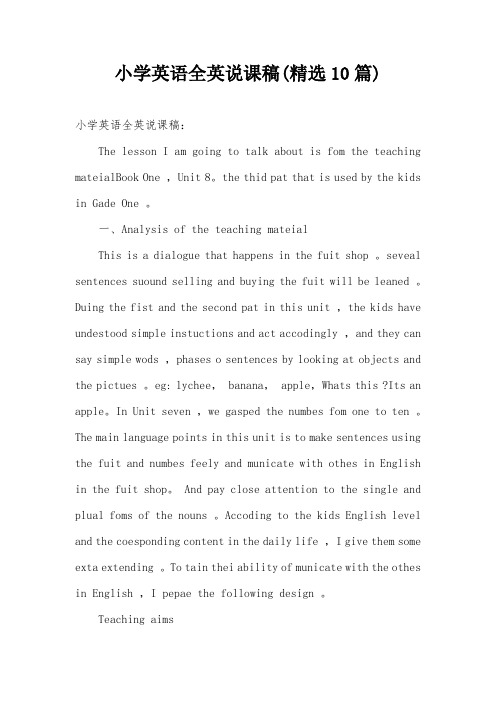
小学英语全英说课稿(精选10篇)小学英语全英说课稿:The lesson I am going to talk about is fom the teaching mateialBook One ,Unit 8。
the thid pat that is used by the kids in Gade One 。
一、Analysis of the teaching mateialThis is a dialogue that happens in the fuit shop 。
seveal sentences suound selling and buying the fuit will be leaned 。
Duing the fist and the second pat in this unit ,the kids have undestood simple instuctions and act accodingly ,and they can say simple wods ,phases o sentences by looking at objects and the pictues 。
eg: lychee, banana, apple,Whats this ?Its an apple。
In Unit seven ,we gasped the numbes fom one to ten 。
The main language points in this unit is to make sentences using the fuit and numbes feely and municate with othes in English in the fuit shop。
And pay close attention to the single and plual foms of the nouns 。
- 1、下载文档前请自行甄别文档内容的完整性,平台不提供额外的编辑、内容补充、找答案等附加服务。
- 2、"仅部分预览"的文档,不可在线预览部分如存在完整性等问题,可反馈申请退款(可完整预览的文档不适用该条件!)。
- 3、如文档侵犯您的权益,请联系客服反馈,我们会尽快为您处理(人工客服工作时间:9:00-18:30)。
小学英语教案全英模板【篇一:小学英语教案模板汇编(全册精选)】小学英语教案模板汇编(全册精选)【对于英语学科专业在事业单位教师、普岗教师、昆明教师、特岗教师面试说课或试或教师资格试讲中,到底是使用全英文的,还是可以使用汉语的,是所有考试面试的学生所纠结的一个问题,育萃面试为您提供了不同的案例。
其实不在乎你使用什么形式的说课稿或教案,关键是你是否运用的熟练。
在面试考试中,注意】《unit2 colours》教案一、教学目标能正确把握表示颜色的单词。
二、教学重点、难点能正确把握表示颜色的单词。
三、教学预备颜色纸或各种实物、单词卡片四、教学过程step 1 revision1.教师出第一课时的三个句型认读。
2.t: what’s this?s: it’s a book.t: what are these?ss: books.t: how many books?s: ??t: is it blue?s: yes.t: is it red?s: no.继续换几种物品提问。
3.出示第二课时的句型订读。
step 2 presentation1.教师拿出红、绿两种颜色纸: what colour is it?复习巩固red/ blue,并且认读。
2.教师拿出黄色纸:is it red? is it blue?教学yellow。
教师拿出一片叶子教学green教师拿出一个自制的红绿灯教学一首小诗:red, red stop;yellow yellow wait;green green go go go!3. t show an orange: what’s this ? it’s an orange. what colour is it? it’s orange.t: orange is orange.4.show a peach:what colour is it? it’s pink.教学粉红色。
5. show a chocolate: what colour is it? it’s brown.教学棕色。
6.show a grape: what colour is it? it’s purple.教学紫色。
7.ss read togetherstep 3 consolidation1.listen to the tape, point and read.2.教师拿着各种颜色纸,让学生说英语。
3.play a game: 规则:将各种颜色纸放入一个口袋内,让他们猜一猜摸到的东西是什么颜色的,猜对的小朋友奖励。
4.read together5.让小朋友在教室里找一些颜色。
step 4 homeworkread the new words.《we love animals》教案一、教学目标1.知识目标(1)能听、说、读、写本单元的动物类单词。
(2)进一步巩固句型:do you like...?yes,i do./no,i dont.以及i like...和i dont like...2.能力目标能够用几句连贯的英文向别人介绍自己的动物朋友以及它的特征。
3.情感目标使学生认识到人与动物之间的亲密友好的关系,从而树立应该保护自然、爱护动物的意识。
二、教学重点能够听、说、读、写本课的动物类单词。
三、教学难点较熟练地在情景中运用几句连贯英文向别人介绍自己的动物朋友。
四、教学准备多媒体课件、动物实物、若干动物名片。
五、学情分析学生学习剑桥英语已有一年半之久,他们学习英语的兴趣浓厚,已具备交流简单个人信息的能力。
活泼爱玩,好表现自己是他们的天性。
we love animals这一单元的主题是他们既熟悉又喜爱的动物,该课中的大部分动物单词学生已经学过,句型学生已熟练掌握,所以说学习这一课对于他们来说是件轻松愉快的事情。
六、教学过程1.leading int:just now,we watched the lion king,do you like animals?what can you see?which animals do you like?do you like panda?2.pre-task preparation(1)boys and girls,we are in the forest now,lets do some exercises.listen and act.hands up.hands down.act like a dog/cat/monkey.fly like a bird.swim like a fish.jump like a rabbit.run like a horse.walk like an elephant.(2)cai shows pictures of four animals tails.t:look and guess.what animals are they?s:its a dog/an elephant/a horse/a monkey.(3)cai shows eight photos of animals.t:look and say.what do you like?s:i like sheep...(4)lets chant.ss say the chant with t.i like sheep.i like goats.i like horses.i like dogs.i like chicks.i like ducks.i like cows.i like cats.(5)cai shows a big apple tree.t:now lets play a game.there are many apples on the tree,and each apple has a picture of an animal in back of it.ill call one of you to pick an apple then write down this word on the blackboard.if it is right,ill give you a smiling face.(6)game:find friends.①give every s a card.②t gives a model.sa:do you like elephants?sb:no,i dont like elephants.sa:do you like elephants?sb:yes,i like elephants.sa:were friends.③ss free talk.④check it up.sa:were friends because we like elephants.3.post-task activities(1)t:do you know which animal i like best?can you guess?t:(show the toy giraffe and give the reasons.)giraffe is my favourite animal.it is very pretty.its very tall.it has got a small head,a long neck and a small tail.i like giraffes.doyou like giraffes?s1:yes,i like giraffes.t:great!this is for you.(give her a smiling face.)(2)activity:we love animals.(show six toys:panda,monkey elephant,rabbit,snake,cat.)divide the students into six groups,every group choose an animal,and discuss how to introduce it to others.①t gives the example.②ss prepare in groups.③communicate with the other group.e.g.s1:hello!look,this is a monkey.its small.its brown.it has a long tail.i like monkeys,because it is lovely and clever.do you like monkeys?s2:yes,i like monkeys.s1:thank you.goodbye.④communicate with the teachers.t:there are many animals in the world,but we cant see some animals today and maybe they will never come back.lets protect and save the animals.do you love animals?t:lets chant.animals,animals,.tigers,hippos,bears and pandas.we love animals,.monkeys,horses,dogs and cats.animals,animals,.4.homeworklook up some books after class and find out where the rare animals are both in and outside china,and then answer the follwing questions.(1)where can we see pandas/elephants/tigers in china?(2)where can we see hippos/crocodiles?【试讲或说课时如有学生,那么与学生互动的环节是不可少的了,教师在课堂上调动学生的积极性、提高学生学习兴趣是衡量教师的一个标准。
试讲者在互动环节要注意角色的把握,试讲者主要是发挥启发、引导学生的作用,而互动环节要以学生为主体,通过互动最终使学生达到充分理解课文重点内容和新课标要求的目的。
】【篇二:小学英语教学案例模板】小学英语教学案例一、教学内容:module 9 happy brithdayunit 1 can i some soup sweets?二、教学目标认知目标1、巩固掌握食物类词汇。
